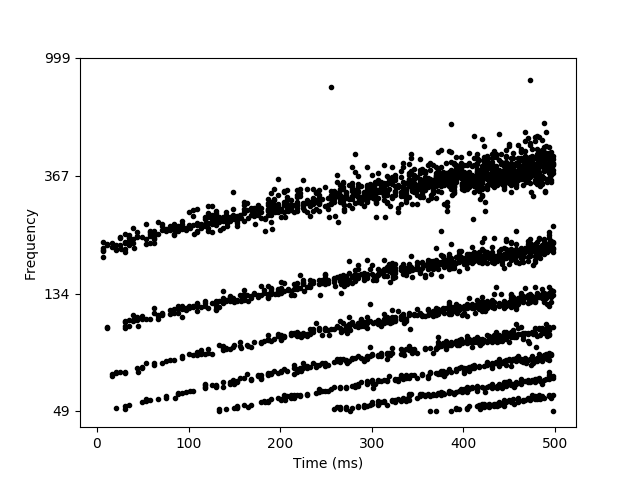Example: licklider
Spike-based adaptation of Licklider’s model of pitch processing (autocorrelation with delay lines) with phase locking.
from brian2 import *
defaultclock.dt = .02 * ms
# Ear and sound
max_delay = 20*ms # 50 Hz
tau_ear = 1*ms
sigma_ear = 0.0
eqs_ear = '''
dx/dt = (sound-x)/tau_ear+0.1*(2./tau_ear)**.5*xi : 1 (unless refractory)
sound = 5*sin(2*pi*frequency*t)**3 : 1 # nonlinear distortion
#sound = 5*(sin(4*pi*frequency*t)+.5*sin(6*pi*frequency*t)) : 1 # missing fundamental
frequency = (200+200*t*Hz)*Hz : Hz # increasing pitch
'''
receptors = NeuronGroup(2, eqs_ear, threshold='x>1', reset='x=0',
refractory=2*ms, method='euler')
# Coincidence detectors
min_freq = 50*Hz
max_freq = 1000*Hz
num_neurons = 300
tau = 1*ms
sigma = .1
eqs_neurons = '''
dv/dt = -v/tau+sigma*(2./tau)**.5*xi : 1
'''
neurons = NeuronGroup(num_neurons, eqs_neurons, threshold='v>1', reset='v=0',
method='euler')
synapses = Synapses(receptors, neurons, on_pre='v += 0.5')
synapses.connect()
synapses.delay = 'i*1.0/exp(log(min_freq/Hz)+(j*1.0/(num_neurons-1))*log(max_freq/min_freq))*second'
spikes = SpikeMonitor(neurons)
run(500*ms)
plot(spikes.t/ms, spikes.i, '.k')
xlabel('Time (ms)')
ylabel('Frequency')
yticks([0, 99, 199, 299],
array(1. / synapses.delay[1, [0, 99, 199, 299]], dtype=int))
show()
